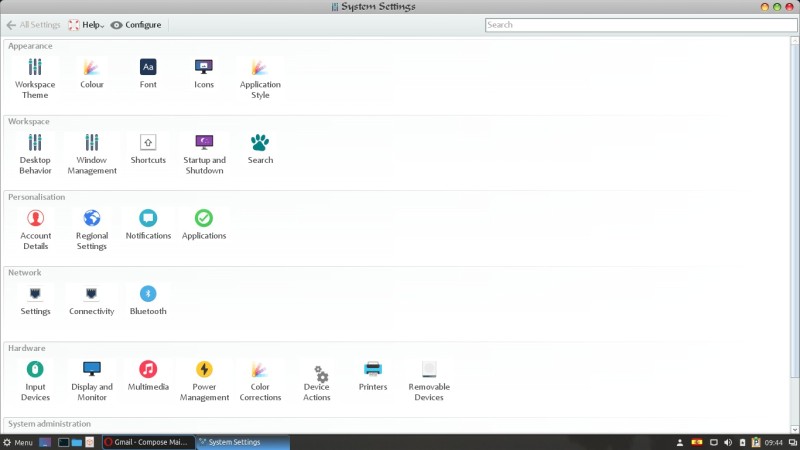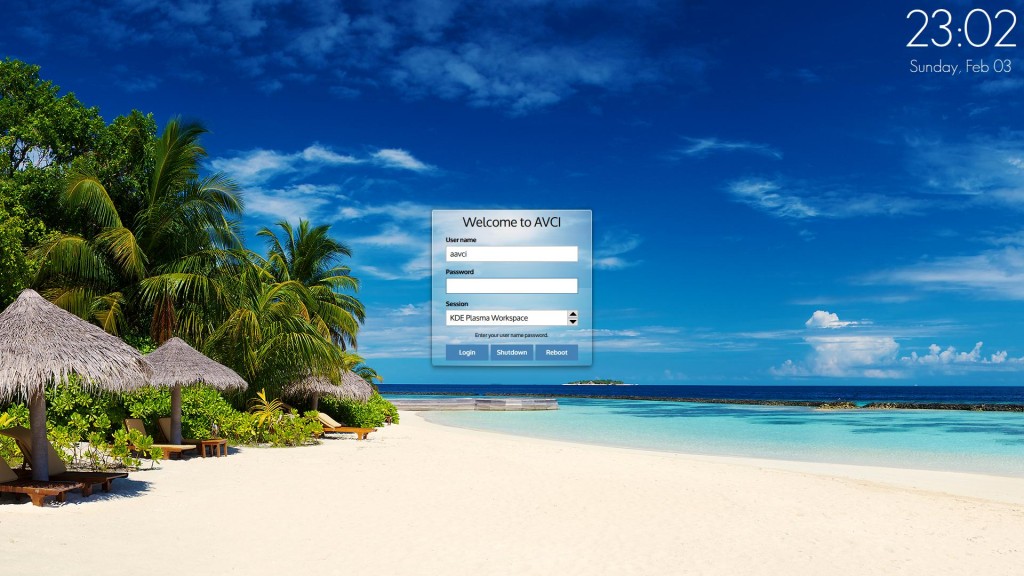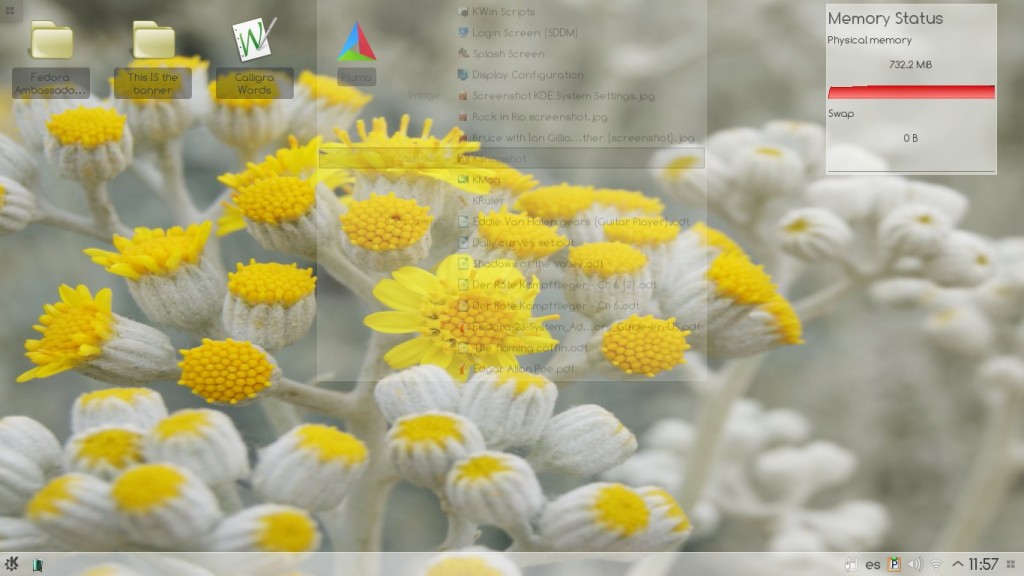KDE Plasma 5 is one of the main desktop spins in Fedora. It’s under heavy development and a lot of things are changing. There are plenty of new features, bug fixing, and optimizing code. It’s an expansive desktop environment with programs for all basic tasks. There are also applications that can be used for sciences, design work, finances, and more.
Installing KDE Plasma 5
To install KDE Plasma 5 in an existing Fedora installation, there are two commands you will use in a command line (i.e. terminal) to do this. They will install the latest version of KDE and extra packages for additional features and functionality. As mentioned earlier, the Plasma 5 desktop is an expansive desktop packed with many features, and the initial installation size will run around 300MB (worth noting for anyone with poor bandwidth or connectivity). After installation, it will expand to about 1GB in total size.
Said that, you can run the following commands for the installation of KDE Plasma 5.
$ sudo dnf group install kde-desktop-environment
You will first be prompted to enter your password (to gain root user privileged temporarily). Afterwards, it will list all of the packages to install, the approximate download size (usually around 300MB), the final size once installed (usually near 1GB). If you are ready to proceed, you can enter
(or the letter that means “yes” in your language) and press enter.
From here, downloading and installing the packages for KDE Plasma 5 will take a while a while. You might want to resume other daily tasks while you’re waiting, depending on your connection speed. If you’re using GNOME or Cinnamon, there should be a notification from the terminal once the installation is finished.
Getting started with KDE Plasma 5
Once it is installed, you can log into KDE Plasma 5 as your desktop environment after restarting your Fedora computer. From the login menu, you can look for a gear-like icon or other symbol (depending on what your initial desktop was) and choose to log in with KDE Plasma 5.
When you first log in, you’ll be greeted by an empty screen and a task bar with a menu on the bottom. To begin making modifications to your new desktop, you will want to open the System Settings application from the menu.
If you are familiar with previous versions of KDE Plasma, you will notice some things have changed since previous releases. There are new methods of applying themes and wallpaper changes. You can pick from what is installed by default or use a site like KDE-Look.org to find additional modifications to your environment.
Color schemes
An interesting feature recently added is that Plasma themes are able to follow color schemes. You can pick a scheme for Qt and apply it your Plasma desktop to have that color scheme reflected in your various windows, applications, and menus.
Adjusting the user icon
As mentioned earlier, the KDE Plasma 5 desktop is under active development, and there are some minor features that are not yet implemented, such as changing your user icon for your account. The developers are aware and are planning on adding ways to do these things in the future. However, in the meanwhile, you can manually add a profile icon by manually placing an image with the name
in the
directory (remember, if you’re using a custom theme, icons may not be supported).
Performance with Plasma 5
For those worried about performance and computer resources, Plasma 5 is a good option. It isn’t as heavyweight as previous versions of KDE Plasma, and you can also reduce the number of effects running in your desktop as well if you need to (I was able to run it well with 1GB of RAM in an Atom notebook).
KDE looks and works nicely with both GTK and Qt programs. This image is just an example of that.
Learn more about KDE Plasma 5
You may want to see what’s new in Plasma 5.You can visit spins.fedoraproject.org to download the KDE spin of Fedora and visit the wiki to read more about using KDE. Additionally, if you have used KDE in the past, you can get a better idea of what is specifically new in this version from a previous article on the Fedora Magazine.











Erik B.
It is nice to have multiple desktop environments installed to try out and switch between in Fedora. I have successfully installed Plasma 5 on top of my Gnome installation, and they cohabit nicely with Cinnamon and I3.
One thing to be on the lookout for is the dependency on rsyslog when installing kde-desktop-environment. If you like rsyslog, no problem. If you want to use syslog-ng, a workaround is needed. Maybe the easiest one is to remove syslog-ng, install rsyslog, run kde-desktop-environment, then substitute in syslog-ng. I think I used a different procedure, but can’t recall the exact steps at the moment.
Thanks for the nice article Sylvia.
Erik
Sylvia Sánchez
I didn’t touch rsyslog/syslog, things just work fine out of the box (thankfully). I had some issues with System Settings though, KDE Bug report take as a crash what is actually me quickly closing down the application.
For the rest, everything runs well.
And thanks to you, glad you liked the article.
Rene Reichenbach
I would not recommend KDE to all who like to use docking stations as the support of changing desktop settings is more or less not in there currently … all comes down to a lot of work …
For all the others enjoy just another good desktop out there for our beloved fedora.
Sylvia Sánchez
Docking station like… what?
Sudhir Khanger
Sylvia you are still rocking Oxygen? Nice.
Sylvia Sánchez
Yep. I like it. And given QT styles aren’t installable anymore, I play with what comes by default. That is not much to be honest. On that point, GTK environments are ahead.
My thought.
Neville A. Cross
I tried once to have multiple desktops, gnome and kde. It turn out that each has a calculator, a plain text editor, a music player and a file manager, just to name a few duplicities you get.
There is a work around to avoid this?
Sebastiaan Franken
Install just one of them, not both. Or remove all the duplicate applications yourself, which can be time consuming.
Sylvia Sánchez
Uninstall those programmes you don’t like. But to be honest, it’s better keeping that duplicity. When something breaks after an update you’ll be grateful of having an alternative. 🙂
i90rr
It’s a packaging issue. Ideally, there should be individual packages for each application and the DE components – then those should be grouped by meta-packages or alike.
In Arch, Gentoo and other OS where you have tight control over your system you can choose to install specific parts of most of the software stacks; however Fedora like Debian chooses the ‘everything-AND-they-kitchen-sink’ approach.
Would be nice to see this issue addressed sometime.
Sylvia Sánchez
While I used Manjaro there was two options: Minimal install which installed the desktop and nothing else, and full install which installed the whole environment. Looks like Plasma 5 got rid of it now, or maybe is a Fedora decision, but it’s recent indeed. I used to have that option on KDE 4 when I used it on Fedora time ago.
i90rr
It’s because Fedora’s packaging guidelines, KDE5 is even more modular than KDE4; in fact using with KDE5 you should be able to install the new Amarok pulling very few KDE dependencies – what makes it quite portable over other DEs.
I remember when I was on Arch that you could install a very minimal KDE base (about 300mb or so), just enough to have the desktop up and running; then you could start adding features like Akonadi, Nepomuk or any of the KDE-specific applications.
Again, with KDE5 this should be even easier to achieve because the ways KDE Libs are now split.
Pavlo Rudyi
“I was able to run it well with 1GB of RAM in an Atom notebook” without browser and another applications. If you need more – 1 GB RAM it’s a joke today.
Sylvia Sánchez
With Opera or Firefox (both installed), Gimp, LibreOffice and some other nice stuff.
Maybe you’d like to read “How do you Fedora, Sylvia Sánchez?”, there’s explained some of the things I do with a 1GB Atom netbook.
I don’t know what people do to need that much RAM. On a 4GB laptop I only use 1GB – 1,2GB as much. Most of time I use around 700MB. Of course, Cinnamon requires less than Plasma but it isn’t that much the difference.
Maybe too many eye candies? I don’t know. But don’t say is a joke. My netbook isn’t a joke at all, it’s pretty useful and serious.
Erik B.
I agree with Sylvia. With Linux, 1 GB RAM can still yield a very useful machine. I have an HP laptop from circa 2005 with 1 GB of RAM, and a chunk of that is shared with the video card. It still works quite well and is useful.
Compare that with Windows 8.1 for instance. I bought an ASUS nettop computer with Windows 8.1 pre-installed on it. Even though Microsoft states that the 2 GB RAM it came with is sufficient to run that version of Windows, it really couldn’t. Runs very happily under Fedora 23 (and 22 and 21).
Erik
Sylvia Sánchez
There’s a Windows 8 on my big laptop. The way Window control the touchpad is utterly irritating. I don’t like the interface.
I can’t say anything else because I rarely use it. Last time I opened it was to confirm my pendrive had died.
Borderliner
I personally prefer GNOME 3, but I guess KDE’s future is brighter. The reason I don’t use KDE Plasma 5 is that it’s not as stable as other desktop environments. I always experience glitchy animations on my widgets, and some Qt applications do not appear as sleek as their GTK counterparts. Though a config-addicted Linux user I am, I’ll try to stick with GNOME 3 for now. 😛
Sylvia Sánchez
I don’t feel comfortable with Gnome 3. I use as main desktop Cinnamon and as secondary Plasma 5. I’m not annoyed with the occasional (in my laptop) glitches, but the lack of features in some of its parts does annoy me. But as it’s under development, I guess it will be fixed… sooner or later.
archuser
Sylvia , if you open multiple tabs in opera then you need more than 1 GB Ram.
Sylvia Sánchez
Well, I haven’t many heads to think at a time, so isn’t very likely I’ll open more than 3 or 5. It depends sometimes of the connection speed, if it’s too slow I open some and wait until the first one finally shows it content. Otherwise I would fall sleep waiting. xD
But seriously, I open a few at a time, I can pay attention to more. Also, I download videos to watch them later offline, that helps to use less RAM.
BTW, do I look hot? Myself? Really?
Sylvia Sánchez
FIXING SENTENCES:
Until the first one finally shows its content **
Sorry!
I can not pay attention to more.
Sorry again!
Mogeni
Someone help me out. whenever I try that out: sudo dnf group install kde-desktop-environment
it gives the feedback that it is already installed
Environment ‘KDE Plasma Workspaces’ is already installed, skipping.
Dependencies resolved.
Nothing to do.
Complete!
What should I do here?
i90rr
You have to log out and choose KDE from the list of available desktops before logging back again.
nicholas
You may need to reboot your computer for the changes to take effect. Then when you select your account, click the gear button below the password box, and select KDE Plasma 5 (or something similar to that) from the drop down menu.
Boris
Just encountered the same issue. I have to remove this group and install it again to get KDE desktop. Otherwise, dnf fails to install some needed packages for KDE session. It is probably a bug.
Erik B.
You might consider something like ‘dnf install plasma-workspace’. I think I used a similar strategy (installing key packages instead of the group) at one point when I first tried this at the end of 2015.
I ran ‘dnf repoquery –requires plasma-workspace’ to see what this might need to pull in. Not a full-fledged KDE system, but maybe enough to get the desktop running.
No guarantees though, as I don’t have anything handy at the moment to try this on.
Hope this helps.
Mogeni
I tried that but it cant install from the terminal. i got some apps from the KDE like amarok and okular.
i90rr
Come join us on the IRC at #fedora on freenode or join the mailing list to help you debug the issue 🙂
Steve
As a long time Gnome user, I am used to it’s layout, and find it unobtrusive to my work flow on a daily basis. There was a time when I was a devout KDE user (back when Mandriva was still available). What I am curious about is how well KDE5 works with Wayland. Have you/anyone tried it with Wayland? If so, what was your results/opinions?
Sylvia Sánchez
I didn’t try Wayland, not in Cinnamon or Plasma 5.
But now you mention it, I will and write a post with my first impressions. Maybe here, or maybe in my own WordPress.
Tim
I really like how KDE looks and feels, but absence of alternative to gnome-extensions is a deal-breaker.
Bartowski
In your write up you mention that there will be two commands that we will use in the command line, but then I only see one command listed (i.e. the dnf install). Was there a second command (configuration or some other package) which you forgot to include?
Sylvia Sánchez
“dnf install @kde”
That’s the other, from what I remember. In Manjaro you can install a minimal thing with the desktop only with a command and a full environment with programmes and things with the other. But Fedora only let’s you install the whole bunch, so it’s good to give a warn.
Tomasz
I’ve just installed the latest KDE on my Fedora 23 laptop with Gnome3 and XFCE. It looks very nice and works stable but there is one thing that make me confused. I don’t know how to change default apps used by some applications – ie: how to change Firefox to use Dolphin instead of Nautilus when I’m using KDE Plasma. The same situation is with Dropbox. I really appreciate if you could give me some tips to resolve this problem.
chriz
System Settings – Personalization – Applications
Leslie Satenstein
A very nice write-up. As a senior Canadian, who occasionally uses KDE, I found a Fedora Remix (Kororaproject),
that wraps the Fedora KDE spin with extra software, such as codecs, and some programs that we who watch videos and listen to music or view DVDs.
I liked this informational presentation.
Vinny
I’ve used KDE until 3.5 version, then i swich to Gnome. When gnome3 arrived, i migrate to MATE, and thats what i’m using now since i was using Sabayon linux(a long time ago) and fedora since fedora 14.
Should I try again the kde?
Sylvia Sánchez
Maybe. Or if you like more the traditional style, consider trying Cinnamon.
Neil
I can’t decide between Cinnamon and Plasma 5.
crossingtheair.wordpress.com
Install them both, use them and then decide. If you can’t decide keep them. I have both desktop installed in my notebook.